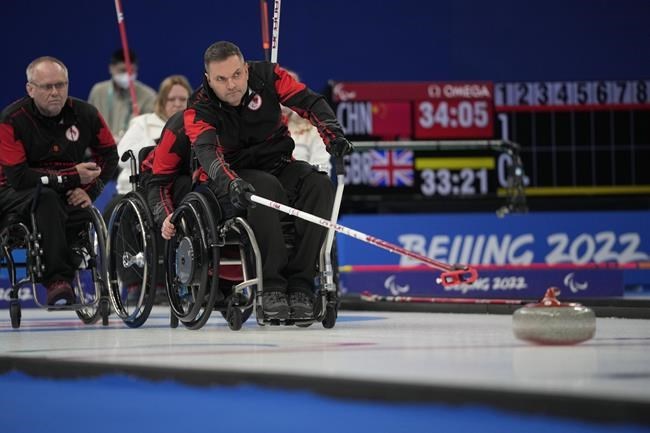Entering a curling club isn't something Mark Ideson takes for granted.
The three-time Paralympian in wheelchair curling says a single stair poses a formidable hurdle to pursue his sport.
"That one stair might as well be Mount Everest because you can't get up that stair independently," Ideson told The Canadian Press.
Ideson skipped Canada to back-to-back bronze medals in the 2018 and 2022 Paralympic Games.
The 46-year-old from London, Ont., who sustained a spinal cord injury in a 2007 helicopter crash that resulted in quadriplegia, was also an alternate on the Canadian team that won gold in 2014.
Ideson spoke at Curling Canada's "Changing The Face of Curling" symposium earlier this year about how just a few weeks after claiming bronze in Beijing, he almost didn't watch his daughter compete in the Canadian under-18 championships because of the club's eight steps up to the viewing area in the lounge and eight steps down to the ice.
A couple of portable ramps got him in a side door to watch his daughter from ice level, but he says it felt like an ordeal.
"Sure, there might be people around willing to help, which is great, but no one wants to rely on help to do all these things," Ideson said.
"You want to be as independent as possible to gain access to a building and gain access to the ice."
New curling club builds in communities such as Chilliwack, B.C., Leduc, Alta., and Chelsea, Que., are accessible, but many Canadian clubs were built in the last century without wheelchairs or other mobility aids in mind.
The first world wheelchair curling championship was in 2002. The sport made its Paralympic debut in 2006.
Ideson is competing in Canada's first wheelchair mixed doubles tournament in Leduc until Sunday.
"I think overall there's been some movement to make curling clubs more accessible in Canada," Ideson said. "There's just a long way to go yet.
"Being part of the national program, we've seen a lot of curling clubs coast to coast. The majority we go to are accessible clubs or clubs who have done the minimum to make the club accessible so we can gain entry to the front door and get onto the ice.
"We wheelchair curlers understand the situation, how the buildings are old and it costs so much money to make these changes, but it's such a benefit to the club and a benefit to people that use chairs who otherwise can't gain access to a social activity or sport like that.
"It's had such a huge impact on my life being able to play."
B.C.'s Oliver Curling Club is taking on an accessibility renovation at Eastlink Curling Centre, which opened in 1970, to install an elevator and convert second-floor washrooms for wheelchair accessibility.
"The way our building is laid out, we certainly have ramps at the front where you can get a wheelchair through the doors and we've had ramps constructed to get out on the ice," club vice-president Brad Dufour said.
"Our dining facility, or lounge, is on the second floor. The ground floor is accessible, not real comfortably, but it works. Washrooms are wheelchair accessible, but upstairs they are not. And the only access is via stairs."
The club successfully applied for a federal grant of $100,000 from the Enabling Accessibility Fund, but the project will cost between $350,000 and $400,000, Dufour said.
"We're a little shell-shocked by the costs," he admitted. "We need to raise additional funds. The fundraising committees are being struck. We're looking at other grants that might be available and continuing to move forward."
If a curling club rents out its lounge or dining room for weddings, parties or corporate events to make money, accessibility is an asset, Dufour said.
Ease of entry and movement throughout the entire building keeps people coming to it, he added.
"There's a lot of older curlers. They might not need elevator access today, but two years down the road, they'd be more than happy to have it," Dufour said.
"It still keeps them in the game and keeps them involved. It's a great thing for the community. It's not just the curling club."
Curling clubs owned and operated by municipalities have made more headway in this area than shareholder-operated clubs because of provinces and territories mandating accessibility and making government grants available.
"All the new clubs that have been built in the last 20 years are fully accessible because government rules say that you have to," said Danny Lamoureux, Curling Canada's executive director of curler experience and curling club development.
"If you're a member-owned club, it's considered a private business even though it's open to the public, those rules don't yet apply to them. They will someday. We'll have to make arrangements and it's going to be difficult for some of those clubs to look at a six-figure bill.
"When it's a new building, you don't see costs and it's when you do renovations where it's really expensive. How to make every curling club in Canada fully accessible, it's going to take a long time."
Lamoureux suggests clubs reach out to their local member of Parliament or provincial legislature to find out what federal or provincial money is available for an accessibility reno.
Curling Canada also offers a low-interest loan up to $30,000 for infrastructure projects.
"That's the big picture and the small picture is do as many little things as you can to improve your accessibility even if it's just getting a ramp built to get in the door," Lamoureux said.
"Reconfigure your washrooms to get better access, even if it's just installing handrails, and that works for an aging population too."
This report by The Canadian Press was first published Dec. 15, 2022.
Donna Spencer, The Canadian Press


